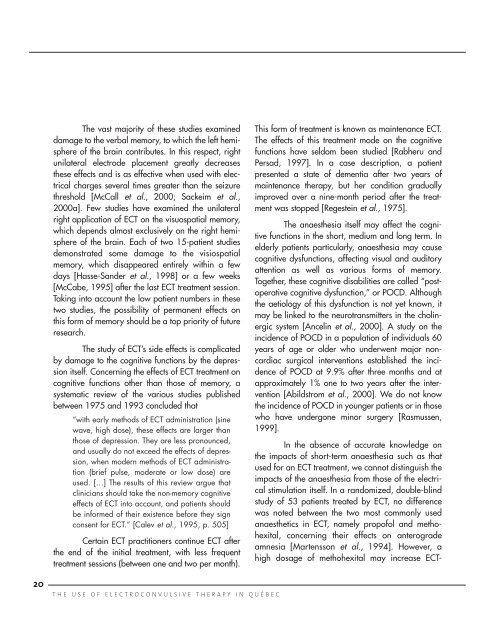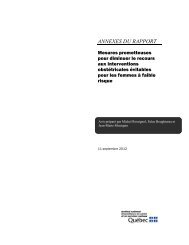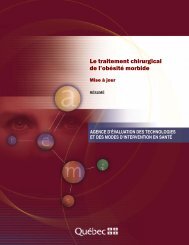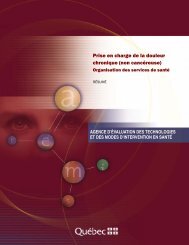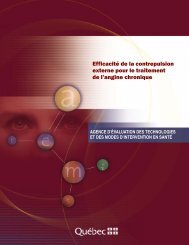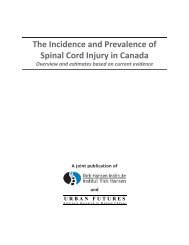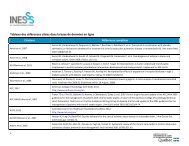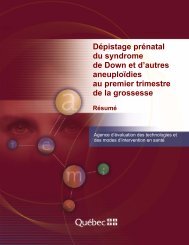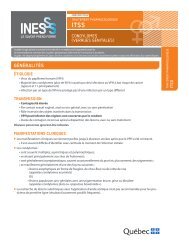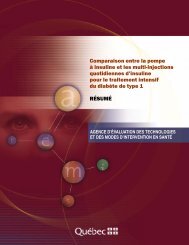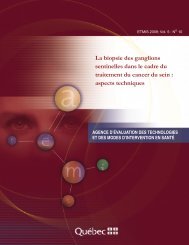The use of electroconvulsive therapy in Quebec - INESSS
The use of electroconvulsive therapy in Quebec - INESSS
The use of electroconvulsive therapy in Quebec - INESSS
You also want an ePaper? Increase the reach of your titles
YUMPU automatically turns print PDFs into web optimized ePapers that Google loves.
20<br />
<strong>The</strong> vast majority <strong>of</strong> these studies exam<strong>in</strong>ed<br />
damage to the verbal memory, to which the left hemisphere<br />
<strong>of</strong> the bra<strong>in</strong> contributes. In this respect, right<br />
unilateral electrode placement greatly decreases<br />
these effects and is as effective when <strong>use</strong>d with electrical<br />
charges several times greater than the seizure<br />
threshold [McCall et al., 2000; Sackeim et al.,<br />
2000a]. Few studies have exam<strong>in</strong>ed the unilateral<br />
right application <strong>of</strong> ECT on the visuospatial memory,<br />
which depends almost exclusively on the right hemisphere<br />
<strong>of</strong> the bra<strong>in</strong>. Each <strong>of</strong> two 15-patient studies<br />
demonstrated some damage to the visiospatial<br />
memory, which disappeared entirely with<strong>in</strong> a few<br />
days [Hasse-Sander et al., 1998] or a few weeks<br />
[McCabe, 1995] after the last ECT treatment session.<br />
Tak<strong>in</strong>g <strong>in</strong>to account the low patient numbers <strong>in</strong> these<br />
two studies, the possibility <strong>of</strong> permanent effects on<br />
this form <strong>of</strong> memory should be a top priority <strong>of</strong> future<br />
research.<br />
<strong>The</strong> study <strong>of</strong> ECT’s side effects is complicated<br />
by damage to the cognitive functions by the depression<br />
itself. Concern<strong>in</strong>g the effects <strong>of</strong> ECT treatment on<br />
cognitive functions other than those <strong>of</strong> memory, a<br />
systematic review <strong>of</strong> the various studies published<br />
between 1975 and 1993 concluded that<br />
“with early methods <strong>of</strong> ECT adm<strong>in</strong>istration (s<strong>in</strong>e<br />
wave, high dose), these effects are larger than<br />
those <strong>of</strong> depression. <strong>The</strong>y are less pronounced,<br />
and usually do not exceed the effects <strong>of</strong> depression,<br />
when modern methods <strong>of</strong> ECT adm<strong>in</strong>istration<br />
(brief pulse, moderate or low dose) are<br />
<strong>use</strong>d. […] <strong>The</strong> results <strong>of</strong> this review argue that<br />
cl<strong>in</strong>icians should take the non-memory cognitive<br />
effects <strong>of</strong> ECT <strong>in</strong>to account, and patients should<br />
be <strong>in</strong>formed <strong>of</strong> their existence before they sign<br />
consent for ECT.” [Calev et al., 1995, p. 505]<br />
Certa<strong>in</strong> ECT practitioners cont<strong>in</strong>ue ECT after<br />
the end <strong>of</strong> the <strong>in</strong>itial treatment, with less frequent<br />
treatment sessions (between one and two per month).<br />
THE USE OF ELECTROCONVULSIVE THERAPY IN QUÉBEC<br />
This form <strong>of</strong> treatment is known as ma<strong>in</strong>tenance ECT.<br />
<strong>The</strong> effects <strong>of</strong> this treatment mode on the cognitive<br />
functions have seldom been studied [Rabheru and<br />
Persad, 1997]. In a case description, a patient<br />
presented a state <strong>of</strong> dementia after two years <strong>of</strong><br />
ma<strong>in</strong>tenance <strong>therapy</strong>, but her condition gradually<br />
improved over a n<strong>in</strong>e-month period after the treatment<br />
was stopped [Regeste<strong>in</strong> et al., 1975].<br />
<strong>The</strong> anaesthesia itself may affect the cognitive<br />
functions <strong>in</strong> the short, medium and long term. In<br />
elderly patients particularly, anaesthesia may ca<strong>use</strong><br />
cognitive dysfunctions, affect<strong>in</strong>g visual and auditory<br />
attention as well as various forms <strong>of</strong> memory.<br />
Together, these cognitive disabilities are called “postoperative<br />
cognitive dysfunction,” or POCD. Although<br />
the aetiology <strong>of</strong> this dysfunction is not yet known, it<br />
may be l<strong>in</strong>ked to the neurotransmitters <strong>in</strong> the chol<strong>in</strong>ergic<br />
system [Ancel<strong>in</strong> et al., 2000]. A study on the<br />
<strong>in</strong>cidence <strong>of</strong> POCD <strong>in</strong> a population <strong>of</strong> <strong>in</strong>dividuals 60<br />
years <strong>of</strong> age or older who underwent major noncardiac<br />
surgical <strong>in</strong>terventions established the <strong>in</strong>cidence<br />
<strong>of</strong> POCD at 9.9% after three months and at<br />
approximately 1% one to two years after the <strong>in</strong>tervention<br />
[Abildstrom et al., 2000]. We do not know<br />
the <strong>in</strong>cidence <strong>of</strong> POCD <strong>in</strong> younger patients or <strong>in</strong> those<br />
who have undergone m<strong>in</strong>or surgery [Rasmussen,<br />
1999].<br />
In the absence <strong>of</strong> accurate knowledge on<br />
the impacts <strong>of</strong> short-term anaesthesia such as that<br />
<strong>use</strong>d for an ECT treatment, we cannot dist<strong>in</strong>guish the<br />
impacts <strong>of</strong> the anaesthesia from those <strong>of</strong> the electrical<br />
stimulation itself. In a randomized, double-bl<strong>in</strong>d<br />
study <strong>of</strong> 53 patients treated by ECT, no difference<br />
was noted between the two most commonly <strong>use</strong>d<br />
anaesthetics <strong>in</strong> ECT, namely prop<strong>of</strong>ol and methohexital,<br />
concern<strong>in</strong>g their effects on anterograde<br />
amnesia [Martensson et al., 1994]. However, a<br />
high dosage <strong>of</strong> methohexital may <strong>in</strong>crease ECT-


